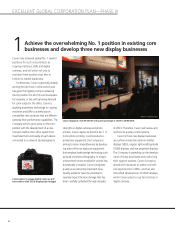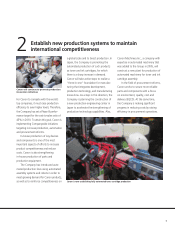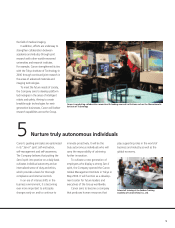Canon 2006 Annual Report Download - page 18
Download and view the complete annual report
Please find page 18 of the 2006 Canon annual report below. You can navigate through the pages in the report by either clicking on the pages listed below, or by using the keyword search tool below to find specific information within the annual report.
16
RESEARCH & DEVELOPMENT
Canon’s engineers around the world are improving upon existing capabilities and
pursuing next-generation technologies to drive business growth.
R&D Expenditure and Patents
Canon is dedicated to maintaining its competitive
edge through a strong emphasis on cutting-edge
research and development, which is reflected in the
high percentage of net sales that Canon allots to such
activities. In 2006, R&D expenses increased ¥21.8
billion from the previous fiscal year to ¥308.3 billion,
accounting for 7.4% of net sales. Looking at spend-
ing by segment, ¥113.8 billion, or 36.9%, went to
business machines, and ¥41.1 billion, or 13.3%, to
cameras. Investment in optical and other products
was ¥29.9 billion, or 9.7% of the total, and basic R&D
that does not belong to any one business segment
was ¥123.5 billion, or 40.1%.
Canon’s extensive and highly advanced R&D
activities have produced a wealth of intellectual
property. In 2006, the Company newly acquired 2,385
patents in the United States, third* among all corpora-
tions, marking the 15th consecutive year Canon has
placed among the top three. The Company will
continue to pursue R&D themes targeting sustainable
growth and endeavor to strengthen its R&D capabili-
ties that lead to the gain of major and basic patents.
Next-Generation Business Domains
Canon is pursuing the development of innovative
technologies that will support its push into new busi-
ness domains. The Company is working to leverage its
expertise in imaging to pioneer advances in such fields
as healthcare. Canon researchers and engineers are
actively engaged in joint research with leading insti-
tutes and universities. For example, in 2006 the
Company teamed up with several departments from
Kyoto University, Japan, to conduct studies in medical
imaging, aiming to revolutionize diagnostic imaging in
order to enable the early detection of illnesses.
Canon conducts research in nanotechnology, the
science and control of matter and light on the
nanometer scale, including research into nanostructural
material, to develop key components and core devices.
In life sciences, Canon has applied inkjet technology to
fabricate reliable DNA chips able to detect genetic muta-
tions that cause cancer and other maladies, and to realize
treatments optimized for each individual patient by accu-
rately identifying types of diseases and stages of progress.
Moreover, Canon is working to develop a new device for
administering medication through a mist sprayed into the
mouth, providing an alternative to injections.
Bolstering Product Competitiveness
Canon strives to be No. 1 in the world in each of its
core business areas by boosting product competitive-
ness. Toward this end, the Company cultivates the
Canon is conducting joint
research with the Tokyo
Institute of Technology
aimed at developing
thin-film transistors
New HD CMOS sensor incorporated in Canon HD camcorders
produces full high-definition video
*Source: U.S. Patent and Trademark Office; Calculated based upon
announcements of weekly totals.
























